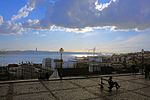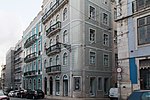Misericórdia
Lisbon geography stubsMisericórdiaParishes of Lisbon

Misericórdia (Portuguese pronunciation: [ˌmizɨɾiˈkɔɾdjɐ]) is a freguesia (civil parish) and district of Lisbon, the capital of Portugal. Located in the historic center of Lisbon, Misericórdia is to the east of Estrela, west of Santa Maria Maior, and south of Santo António. It is home to numerous famous neighborhoods, including Bairro Alto, Príncipe Real, and parts of Chiado. The population in 2011 was 13,044.
Excerpt from the Wikipedia article Misericórdia (License: CC BY-SA 3.0, Authors, Images).Misericórdia
Calçada do Combro, Lisbon Bairro Alto (Misericórdia)
Geographical coordinates (GPS) Address Nearby Places Show on map
Geographical coordinates (GPS)
| Latitude | Longitude |
|---|---|
| N 38.711 ° | E -9.148 ° |
Address
Calçada do Combro 76-82
1200-115 Lisbon, Bairro Alto (Misericórdia)
Portugal
Open on Google Maps








